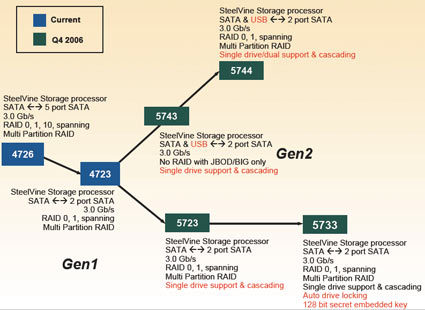Silicon Image Brings Virtualization to eSATA
SteelVine Storage Processors Gen. 2
The first generation of SteelVine products was represented by the Sil4723, which is a two-port SATA/300 controller with RAID support and out-of-band managing option. It is different from other entry-level RAID controllers because it doesn't require drivers or BIOS support, and you can easily upgrade from a single drive to RAID 1 later on.
There are four new storage processors available in SteelVine generation 2: Sil5723, 5733, 5743 and 5744. All of them come in a very compact 10x10 mm QFN package (quad flat no lead) and support the features of SteelVine generation 1 as well as Silicon Image's new drive virtualization layer to cascade SteeVine gen. 2 eSATA devices. Models Sil5723 and 5733 were designed with only eSATA in mind, making them suitable solutions for embedded applications. Think of the Sil5723 and 5733 as RAID and storage virtualization coprocessors on a motherboard, for example. Except for the Sil 5743, all models support various RAID modes that can combine capacity expansion with a limited storage space that mirrors data. Sil5743 and 5744 were designed specifically with external storage devices in mind, which is why they do not only support eSATA system uplinks, but they support USB 2.0 as well. We believe this is highly important to maintain maximum flexibility. The 5743 does not support RAID modes, though.
The possibility to cascade drives may not look very important, but there are various scenarios where this makes sense: If you only have a single eSATA port you will be glad if you can attach a second eSATA drive to an existing one (simple port multiplying). Another possible application is VCRs: More and more carry an eSATA port, but what if you wanted to expand the capacity after having already added an eSATA hard drive? Of course, the technology can also be used to mirror data from one SteelVine eSATA drive to another one. Silicon Image provides several operating modes, ranging from simple capacity expansion over mirroring (called SAFE) all the way to two multi-partition RAID modes called SAFE33 and SAFE50. Each of these create two logical drives, one that is mirrored across two drives, utilizing 33% or 50% of the available capacity, and the second one concatenating the remaining storage capacity of both drives in a single storage partition. Silicon Image supports auto rebuild in hardware (no additional CPU utilization during rebuild).
All SteelVine Generation 2 storage processors include the host interface, an additional SATA interface, a virtualization logic and a RISC processor to take care of all the requirements of the virtualized drive environment.
Get Tom's Hardware's best news and in-depth reviews, straight to your inbox.
Current page: SteelVine Storage Processors Gen. 2
Prev Page The Key: SATA Port Multipliers Next Page Prototype SteelVine Gen. 2 Hard Drives
Patrick Schmid was the editor-in-chief for Tom's Hardware from 2005 to 2006. He wrote numerous articles on a wide range of hardware topics, including storage, CPUs, and system builds.

